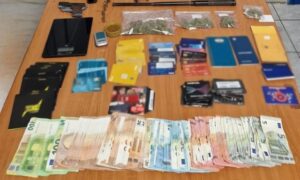The 540-page dossier on the case of the ghost car ring excerpts of which are still being published today by protothema.gr, brings to light the well-organized and hierarchical structure of the criminal group, which relied on the specialized knowledge of electronic banking, but also on the communication skills of its members, who spoke fluent Greek.
Coordination, discipline and specialization were the cornerstones of their actions, making the circuit extremely effective and difficult to detect.
At the top of the hierarchy were the leaders of the organization. They were in complete control, describing the group’s purpose: obtaining illegal property gains through systematic deception of citizens and legal entities.
Their orders were binding on all members, defining the methodology of action and ensuring the uninterrupted operation of the circuit.
The directors were mainly located in areas such as Zevgolatio, Examilia Corinthia and Argos Argolida, where they acted as central points of coordination and financial management of the illicit proceeds.
Following them in the hierarchy, at the middle level, were the senior and ordinary members of the organization. These included recruiters, telephone operators, bank account managers and money collectors. These members had distinct roles, but worked closely together under the direction of the managers, making a decisive contribution to achieving the common goal.
Their every action, from collecting evidence to withdrawing money and communicating with victims, was deliberate and essential to the overall operation of the scheme.
The base of the pyramid included the so-called “money mules”. These were individuals who would give up their banking details, such as cards, e-banking accounts and mobile phones linked to these accounts, for a small fee ranging from 300 to 800 euros.
These items were first passed on to recruiters and then to the directors, who used the accounts to transfer or hide the illegal profits. In most cases, each account was used only once, which required constant recruitment of new individuals.
The documentation also reveals the existence of a call center that played a key role in the fraud. Members of the call center, who spoke fluent Greek and had an excellent knowledge of electronic banking, communicated with the victims using specialised techniques to deceive them.
Their training in the use of electronic devices and the functions of the banking system allowed them to appear convincing and reliable, while coordinating their actions with the central headquarters.
The organization’s operational center was responsible for collecting bank details, withdrawing money and reselling goods obtained through the fraud. The card collection department collected and verified the functionality of the data, while the withdrawal and product receipt departments handled financial transactions and “revenue” management. The coordinators ensured the smooth flow of activities, adjusting the composition of the members according to the needs of the organization.
The “money mules” were the last but crucial part of the chain. Without their involvement, criminal activity would have been difficult. They would provide their evidence, often knowing it was being used for illegal activities, but would be persuaded or blackmailed into participating due to financial difficulties. Indeed, in several cases, they were instructed to report the theft of their data to the authorities in order to deflect responsibility.
The voluminous dossier outlines an organisation with a clear hierarchy, a well-organised structure and expertise, which exploited every opportunity of the modern banking system to achieve its aims.
Ask me anything
Explore related questions





